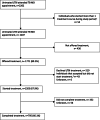Seven-year retrospective study understanding the latent TB infection treatment cascade of care among adults in a low incidence country
- PMID: 34020616
- PMCID: PMC8140464
- DOI: 10.1186/s12889-021-10733-9
Seven-year retrospective study understanding the latent TB infection treatment cascade of care among adults in a low incidence country
Abstract
Background: Prevention of TB is paramount to achieving elimination targets as recommended by the World Health Organization's action framework for low incidence countries striving to eliminate TB. Although the rates of TB in Canada are low, understanding the latent TB infection (LTBI) cascade is paramount to identifying gaps in care and treatment barriers, thereby increasing the effectiveness of preventive strategies. The purpose of this study was to examine the LTBI cascade of care and identify barriers to treatment completion in adults referred from primary care to a regional tertiary care TB clinic in Ottawa, Canada.
Methods: Electronic medical records between January 2010 and December 2016 were reviewed retrospectively and an LTBI cascade of care was constructed from The Ottawa Hospital TB clinic and surrounding primary care clinics. A cohort of 2207 patients with untreated LTBI was used to ascertain the associations between demographic and clinical factors for both treatment non-initiation and non-completion using log-binomial univariable and multivariable regression models.
Results: Of 2207 patients with untreated LTBI who were seen in the clinic during the study period, 1771 (80.2%) were offered treatment, 1203 (67.9% of those offered) started treatment, and 795 (66.1% of those started) completed treatment. In multivariable analysis, non-initiation of treatment was associated with older age (adjusted risk ratio [aRR] 1.06 per 5-year increase, 95% CI: 1.03-1.08) and female gender (aRR 1.28, 95% CI: 1.11-1.47). Non completion of treatment was associated with referral from the TB Clinic back to the primary care team following initial consult (aRR 1.62, 95% CI: 1.35-1.94) and treatment with the standard of 9 months of Isoniazid (9H) compared to 4 months of Rifampin (4R) (aRR 1.45, 95% CI:1.20-1.74).
Conclusions: LTBI treatment completion was significantly decreased among patients who were referred back to primary care from the TB clinic. The 4R regimen resulted in more people completing LTBI treatment compared to 9H in keeping with a recently published RCT. Improved education, communication, and collaboration between tertiary care TB clinics and primary care teams may improve treatment completion rates and address the TB burden in low incidence communities in Canada.
Keywords: Cascade of care; Latent tuberculosis infection.
Conflict of interest statement
There are no competing interests to declare.
Figures




References
-
- Organization WH . Global Tuberculosis Report. 2020.
-
- Organization GWH. Global Tuberculosis Report 2019. Executive Summary. 2019 17 October 2019. Contract No.: WHO/CDS/TB/2019.15.
Publication types
MeSH terms
Substances
LinkOut - more resources
Full Text Sources
Other Literature Sources

